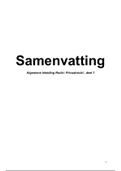Table of Contents
Factor Analysis ................................................................................................................. 3
Analysis process ....................................................................................................................... 5
1. Problem formulation ........................................................................................................................... 5
2. Construct correlation matrix: .............................................................................................................. 5
3. Selecting an extraction method........................................................................................................... 6
4. Determining number of factors and rotation .................................................................................... 10
5. Interpreting factors ........................................................................................................................... 12
6. Using factors in other analyses, so you can do regression after FA .................................................. 13
7. Determine model fit .......................................................................................................................... 14
Most important Steps FA analysis in short .............................................................................. 16
Ancova ........................................................................................................................... 19
2.1 Purpose ..................................................................................................................... 19
2.2 Different types of ANOVA .......................................................................................... 19
2.3 Objective of Covariance Analysis ................................................................................ 19
2.4 Understanding the logic ............................................................................................. 19
2.5 Research process & application .................................................................................. 21
2.6 Main vs interaction effect .......................................................................................... 23
2.7 N-way ANOVA VS ANCOVA ........................................................................................ 25
2.8 Assumptions and Interpretation ................................................................................. 25
2.9 SPSS output assumptions ........................................................................................... 26
2.10 Manova ..................................................................................................................... 33
Multiple Regression Analysis .......................................................................................... 36
3.1 MRA................................................................................................................................. 36
3.2 Process of multiple regression analysis (MRA) ................................................................... 37
3.3 Objectives of multiple regression: ..................................................................................... 38
3.4 Research Design of MRA ................................................................................................... 39
3.5 Assumptions, estimation and model fit ............................................................................. 40
3.6 Interpretation .................................................................................................................. 44
3.7 Issues in Interpretation:.................................................................................................... 45
3.8 Moderating effects in MRA ............................................................................................... 46
3.9 Analysis report with SPSS output ...................................................................................... 48
3.10 Logistic regression .......................................................................................................... 53
PLS SEM ......................................................................................................................... 57
4.1 Purpose............................................................................................................................ 57
4.2 Structural Equation modeling with PLS – process............................................................... 59
4.3 Individual constructs ........................................................................................................ 60
,4.4 Specify model ................................................................................................................... 60
4.5 assumptions and requirements ......................................................................................... 61
4.6 Assessing measurement model ......................................................................................... 63
4.7 Assessing structural model ............................................................................................... 67
4.8 Bootstrapping .................................................................................................................. 68
4.9 Assignment with SPSS Output ........................................................................................... 71
4.10 Mediating effect ............................................................................................................. 75
4.11 Moderating effects ......................................................................................................... 76
2
,Factor Analysis
What is factor analysis?
- Interdependence technique (how different items interrelate with each other)
- Define structure among variables
- Interrelationships among large number of variables to identify underlying dimensions
-> underlying dimensions are called factors.
- Data summarization and reduction
Data summarization: you want to summarize data and you want to understand the dimensions
Reduction: You want to reduce your data observation so you can use it in other
Purpose:
Estimate a model which explains variance/covariance between a set of observed variables
(collected data) (in a population) by a set of unobserved factors & weighting
Variance refers to the spread or dispersion of values, while covariance measures how two
variables change together. Variance and covariance interrelate with each other.
With confirmatory factor Analysis you have a priori idea that you have 3 factors, this does
not change.
However, with exploratory you don’t know this yet.
Construct (gig circle)
x = underlying items
E = error. Are there any
systematic biases that really
influence how we measured the
items because we work with latent
variables.
So, with factor analysis you can assess this type of measurement error.
3
, Construct= latent variable
Items/indicators= Operation, empirical concept as measured. For questionnaire base each
indicator represents a particular question.
With factor analysis you can have e.g. 4 of those measurement models when you have 4
factors.
Why Multi-item measurement?
- Increases reliability and validity of measures
- Allows measurement and validity of measures (measurement error, reliability,
validity)
Measurement error= inaccuracies of measuring the “true” variable values due to the
fallibility of the measurement instrument (ie. Inappropriate response scales), data entry errors,
or respondent errors.
Validity = extent to which a measure or set of measures correctly represents the concept of
study – the degree to which it is free from any systematic or non-random error. Validity is
concerned with how well the concept is defined by the measure(s), whereas reliability relates
to the consistency of the measure(s)
"Does the measure really measure what it claims to measure?"
Reliability= Extent to which a variable or set of variables is consistent in what it is intendent
to measure. If multiple measurements are taken, the reliable measures will all be consistent in
their values. It differs from validity in that it relates to what should be measured, but instead
to how it is measured.
"Does the measure give consistent results when used repeatedly?"
Two forms of measurement models: formative (emerging) & reflective (latent)
Formative: more items, and they together emerge into the construct.
Reflective: there is a construct, and the items reflect this construct
Mostly the reflective is used.
Correlated indicators= items that correlated with each other and the correlations are used in
the FA to explain the factor.
λ= Factor loadings
4
Factor Analysis ................................................................................................................. 3
Analysis process ....................................................................................................................... 5
1. Problem formulation ........................................................................................................................... 5
2. Construct correlation matrix: .............................................................................................................. 5
3. Selecting an extraction method........................................................................................................... 6
4. Determining number of factors and rotation .................................................................................... 10
5. Interpreting factors ........................................................................................................................... 12
6. Using factors in other analyses, so you can do regression after FA .................................................. 13
7. Determine model fit .......................................................................................................................... 14
Most important Steps FA analysis in short .............................................................................. 16
Ancova ........................................................................................................................... 19
2.1 Purpose ..................................................................................................................... 19
2.2 Different types of ANOVA .......................................................................................... 19
2.3 Objective of Covariance Analysis ................................................................................ 19
2.4 Understanding the logic ............................................................................................. 19
2.5 Research process & application .................................................................................. 21
2.6 Main vs interaction effect .......................................................................................... 23
2.7 N-way ANOVA VS ANCOVA ........................................................................................ 25
2.8 Assumptions and Interpretation ................................................................................. 25
2.9 SPSS output assumptions ........................................................................................... 26
2.10 Manova ..................................................................................................................... 33
Multiple Regression Analysis .......................................................................................... 36
3.1 MRA................................................................................................................................. 36
3.2 Process of multiple regression analysis (MRA) ................................................................... 37
3.3 Objectives of multiple regression: ..................................................................................... 38
3.4 Research Design of MRA ................................................................................................... 39
3.5 Assumptions, estimation and model fit ............................................................................. 40
3.6 Interpretation .................................................................................................................. 44
3.7 Issues in Interpretation:.................................................................................................... 45
3.8 Moderating effects in MRA ............................................................................................... 46
3.9 Analysis report with SPSS output ...................................................................................... 48
3.10 Logistic regression .......................................................................................................... 53
PLS SEM ......................................................................................................................... 57
4.1 Purpose............................................................................................................................ 57
4.2 Structural Equation modeling with PLS – process............................................................... 59
4.3 Individual constructs ........................................................................................................ 60
,4.4 Specify model ................................................................................................................... 60
4.5 assumptions and requirements ......................................................................................... 61
4.6 Assessing measurement model ......................................................................................... 63
4.7 Assessing structural model ............................................................................................... 67
4.8 Bootstrapping .................................................................................................................. 68
4.9 Assignment with SPSS Output ........................................................................................... 71
4.10 Mediating effect ............................................................................................................. 75
4.11 Moderating effects ......................................................................................................... 76
2
,Factor Analysis
What is factor analysis?
- Interdependence technique (how different items interrelate with each other)
- Define structure among variables
- Interrelationships among large number of variables to identify underlying dimensions
-> underlying dimensions are called factors.
- Data summarization and reduction
Data summarization: you want to summarize data and you want to understand the dimensions
Reduction: You want to reduce your data observation so you can use it in other
Purpose:
Estimate a model which explains variance/covariance between a set of observed variables
(collected data) (in a population) by a set of unobserved factors & weighting
Variance refers to the spread or dispersion of values, while covariance measures how two
variables change together. Variance and covariance interrelate with each other.
With confirmatory factor Analysis you have a priori idea that you have 3 factors, this does
not change.
However, with exploratory you don’t know this yet.
Construct (gig circle)
x = underlying items
E = error. Are there any
systematic biases that really
influence how we measured the
items because we work with latent
variables.
So, with factor analysis you can assess this type of measurement error.
3
, Construct= latent variable
Items/indicators= Operation, empirical concept as measured. For questionnaire base each
indicator represents a particular question.
With factor analysis you can have e.g. 4 of those measurement models when you have 4
factors.
Why Multi-item measurement?
- Increases reliability and validity of measures
- Allows measurement and validity of measures (measurement error, reliability,
validity)
Measurement error= inaccuracies of measuring the “true” variable values due to the
fallibility of the measurement instrument (ie. Inappropriate response scales), data entry errors,
or respondent errors.
Validity = extent to which a measure or set of measures correctly represents the concept of
study – the degree to which it is free from any systematic or non-random error. Validity is
concerned with how well the concept is defined by the measure(s), whereas reliability relates
to the consistency of the measure(s)
"Does the measure really measure what it claims to measure?"
Reliability= Extent to which a variable or set of variables is consistent in what it is intendent
to measure. If multiple measurements are taken, the reliable measures will all be consistent in
their values. It differs from validity in that it relates to what should be measured, but instead
to how it is measured.
"Does the measure give consistent results when used repeatedly?"
Two forms of measurement models: formative (emerging) & reflective (latent)
Formative: more items, and they together emerge into the construct.
Reflective: there is a construct, and the items reflect this construct
Mostly the reflective is used.
Correlated indicators= items that correlated with each other and the correlations are used in
the FA to explain the factor.
λ= Factor loadings
4










